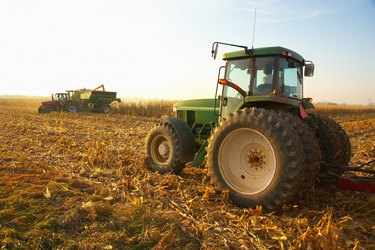
Raised rows and beds in farming and gardening promote good drainage, less soil erosion, earlier crops and well-drained, warmer soil. Disc hillers and bed shapers are useful tractor implements for creating either single or multiple raised rows and beds. Experienced box blade users can also form raised rows but at a slower pace.
Box Blade
Video of the Day
A box blade can form raised rows for planting crops. The tractor operator needs considerable experience is using this tractor implement to be successful. Setting a box blade down and biting into the soil will fill the box up with soil. Then to redistribute the soil, you elevate the box blade so that the soil spills out in a deep pile to make your raised rows. Farmers use this time-consuming method on a small-scale basis.
Video of the Day
Disc Hiller
Disc hillers attach to the power take off (PTO) on a tractor to create raised rows with furrows between them. Disc hillers are available in single-row, four-row, six-row and eight-row hillers. This implement is adjustable for the height and width of the raised rows. Single-row disc hillers may attach to the back of a tractor to create raised rows behind it, or they may be a side hiller, which creates rows beside the tractor. Multiple-row hillers create rows behind the tractor.
Bed Shapers
Bed shapers operate on the same basis as a disc hillers in attaching to the tractor PTO. This type of implement can also create multiple rows behind the tractor. A bed shaper can be useful as a one-pass implement or a two-pass implement. You can perform each pass at a higher rate of speed. The first pass roughs in the raised rows, and the second pass flattens the tops of the rows so that the planter can have a solid surface to plant seeds and cover them without much soil spillage into the furrows.
Considerations
When choosing a tractor implement for raised rows, there are a few factors to consider. The multiple-row hillers and shapers are heavy-duty construction, but the increased number of rows produced also increases the strength of the implement. This is due to the weight of the implement and the drag that it has on your tractor. Raised-row implements are classified by the amount of horsepower (HP) that your tractor can achieve while pulling them. If you choose a model that is too heavy for your tractor, you will have to travel at a slower speed, and you may not be able to produce clean rows and furrows. Also, plan the size of your rows and furrows so that your other implements will be spaced appropriately for planting and harvesting. Wide rows sometimes work best when double planted instead of narrow rows that are single planted.